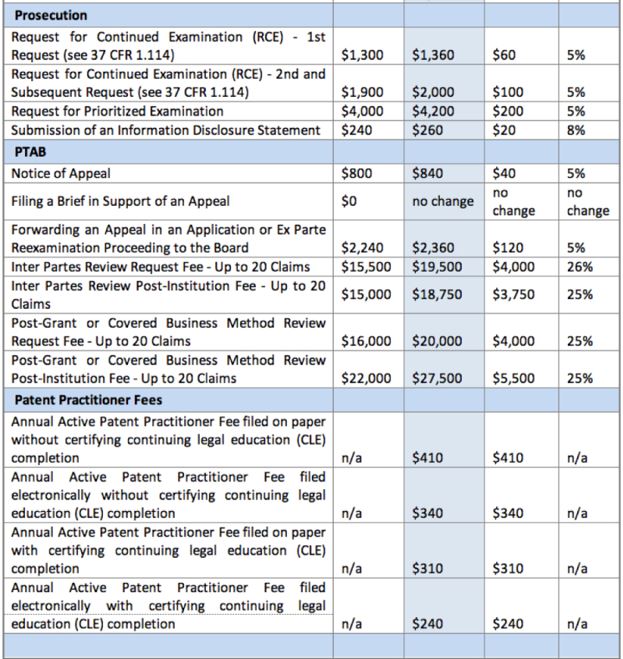The PTAB has designated five new decisions as informative, three on IPR practice procedure and two ex parte decisions (one on issue preclusion and one on claim construction):
Ariosa Diagnostics v. Isis Innovation Ltd., IPR2012-00022, Paper 55 (PTAB Aug. 7, 2013)
Here the Board provides guidance on foreign depositions, both on the location where they are taken and the language in which they are conducted. The Board emphasizes that “the parties are in the best position to determine the procedure by which the deposition is to be conducted” but provides 12 general guidelines for procedures to use for depositions in foreign languages covering such topics as 1). each sides’ right to bring an interpreter, 2). protocol for resolving disagreements between interpreters on their respective interpretations, and 3). notice requirements on documents which will be “sight read” at the deposition. The full list is available in the decision linked above.
Ex parte Jung, 2016-008290 (PTAB Mar. 22, 2017)
In this appeal, the appellant challenged the examiner’s interpretation that the claim language “at least one of a connection branch and a contents connection list” required only ‘a connection branch’ OR ‘a contents connection list’ as opposed to requiring both of their presence. In their reversal, the Board applied the ruling from the Federal Circuit in SuperGuide Corp. v. DirecTV Enterprises, Inc., which explained that the plain meaning of ‘at least one of A and B’ is the conjunctive phrase ‘at least one of A and at least one of B.”[1] The Board explained that the plain meaning could have been rebutted with a demonstration that the other claims, specification, or the prosecution history necessitated a broader interpretation, but, absent such a showing, the examiner erred.
Argentum Pharm. LLC v. Alcon Research, Ltd., IPR2017-01053, Paper 27 (PTAB Jan. 19, 2018)
In this decision, the Board offers an analysis on the ‘good cause’ standard for protective orders. The Board denied a motion for a protective order without prejudice for failure to demonstrate that “(1) the information sought to be sealed is truly confidential, (2) a concrete harm would result upon public disclosure, (3) there exists a genuine need to rely in the trial on the specific information sought to be sealed, and (4), on balance, an interest in maintaining confidentiality outweighs the strong public interest in having an open record.”[2]
Colas Sols. Inc. v. Blacklidge Emulsions, Inc., IPR2018-00242, Paper 9 (PTAB Feb. 27, 2018)
The decision here applies to § 315 bars to institution in IPRs. Specifically, the Board found institution was barred when a petitioner has previously filed for a declaratory judgment of invalidity on the same patent. Furthermore, the Board ruled that a motion for joinder could not save a petitioner from the statutory bar under § 315(a)(1). In its reasoning, the Board explains that while a § 315(b) time bar is specifically excluded in instances of joinder under § 315 (c), the statutory bar for § 315(a)(1) provides for no such exemption.
Ex parte Ditzik, 2018-000087 (PTAB Mar. 2, 2018)
Here, the Board upheld an examiner’s use of issue preclusion from a related invalidity finding against the applicant in District Court. In so doing, the Board found the following arguments by the appealing applicant accurate, but unpersuasive with respect to issue preclusion: 1). The fact that the claims are not the same in the proceedings; 2). The procedural possibility for the District Court ruling to be overturned; and 3). The PTO’s absence as a party from the District Court proceeding. While the Board did not find any of the following in this case, it allowed for potential rebuttals to issue preclusion when 1). The standard applied in the prior final decision might have caused a different outcome than before the Board; 2). Evidence available now was demonstrated to not be available at the time of the prior proceeding; or 3). There was otherwise not a ‘full and fair opportunity to litigate’ in the prior proceeding and the Board wishes to exercise its discretion despite the motivations of efficiency and consistency for issue preclusion.
Each decision is linked in the respective heading above for more information and reference, and a full list of all precedential and informative decisions is available here.
[1] 358 F.3d 870, 885-86 (Fed. Cir. 2004).
[2] 37 C.F.R. § 42.54(a).

